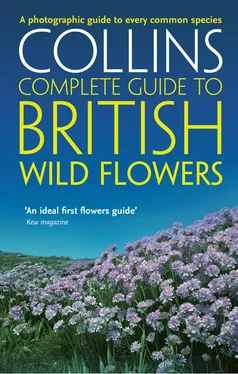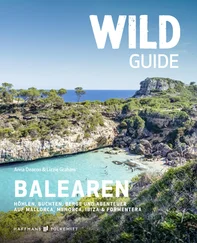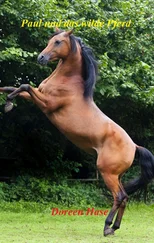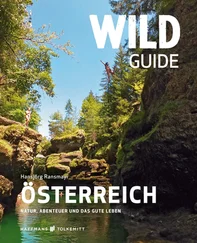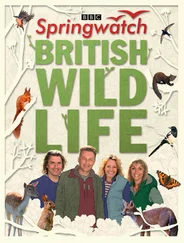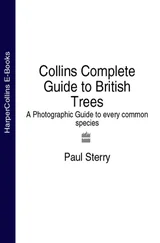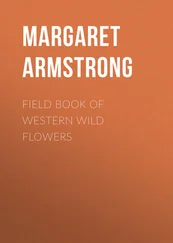Centuries of woodland coppicing have inadvertently created the perfect environment for Bluebells to thrive. A carpet of these lovely plants is a quintessentially English scene.
Areas of native conifer woodland are restricted to a few relict pockets of Caledonian pine forest in the Highlands of Scotland. Conifers that are seen almost everywhere else in Britain and Ireland have either been planted or have seeded themselves from mature plantations. Our native conifer forests harbour an intriguing selection of plants, such as various wintergreen species, Twinflower and Creeping Lady’s-tresses, but conifer plantations are usually species-poor.
Once so much a feature of the British countryside, hedgerows have suffered a dramatic decline in recent decades. Many hedgerows have either been grubbed out by farmers keen to expand arable field sizes or, more insidiously, wrecked – both in terms of appearance and in their value to wildlife – by inappropriate cutting regimes.
The extent of scrub in the landscape has also diminished in recent times. Although scrub is difficult to define in strict habitat terms, most people would understand the word to mean a loose assemblage of tangled, medium-sized shrubs and bushes interspersed with patches of spreading plants such as Bramble and areas of grassland. Scrub is frequently despised by landowners – sometimes even by naturalists too – but its value to many species formerly considered so common and widespread as not to merit conservation attention should not be underestimated.
Hedgerows usually comprise the species, and acquire the character, of any woodland edge in the vicinity. Scrub, too, reflects the botanical composition of the surrounding area. However, because scrub is essentially a colonising habitat, and not an established one, the bushes and shrubs that comprise tend to be those that grow the fastest.
Full of wild flowers and native grass species, a good grassy meadow is a delight to anyone with an eye for colour and an interest in natural history. Unfortunately, prime sites are comparatively few and far between these days, either lost to the plough or ‘improved’ by farmers for grazing, by seeding with fast-growing, non-native grass species and by applying selective herbicides. When this happens, the grassland loses its intrinsic botanical interest and value.
It should not be forgotten that, in Britain and Ireland, grassland is a man-made habitat, the result of woodland clearance for grazing in centuries past. If a site is to be maintained as grassland, continued grazing or cutting is needed to ensure that scrub does not regenerate. In the past, the way in which grassland was managed had the beneficial side-effect – from a naturalists’ perspective – of increasing botanical diversity. Under modern ‘efficient’ farming regimes the reverse is the case.
Although arable fields may fall loosely into the category of grasslands (crop species such as wheat, barley and oats are grasses after all), their botanical interest tends to be minimal in many areas. Modern herbicides ensure that ‘weeds’ are kept to a minimum, and decades of chemical use have resulted in the soil’s seed bank being depleted dramatically. Many of the more delicate arable ‘weed’ species are essentially things of the past, often relegated to a few scraps of marginal land that escape spraying either by luck or, in a few instances, through the foresight of farmers. Arable weeds depend on disturbance, being unable to compete in stable grassland communities. So there is a sad irony to the fact that grant-funded ‘conservation’ schemes that create wildlife ‘headlands’ are often the final nail in the coffin for these scarce species, which become crowded out by the vigorous growth of seeded rank grasses and clovers.
Heathlands are essentially restricted to southern England, with the majority of sites concentrated in Surrey, Hampshire and Dorset. However, further isolated examples of heath-land can be found further afield, in south Devon and Suffolk, for example, and in coastal districts of Cornwall and Pembrokeshire. This fragmented distribution adds to the problems that beset the habitat: ‘island’ populations of plants and animals have little chance of receiving genetic input from other sites.
Heathland owes its existence to man, and came about following forest clearance on acid, sandy soils. Regimes of grazing, cutting and periodic burning in the past have helped maintain heathland, and continued management is needed to ensure an appropriate balance between scrub encroachment and the maintenance of an open habitat. Ironically, man is also the biggest threat to the habitat: uncontrolled burns cause damage that takes decades or more to repair, while the destruction of heathland for housing developments obviously means the loss of this unique habitat for good.
The habitat’s name is clearly derived from the presence, and often dominance, of members of the heath family of plants, all of which flourish on acid soils. For the ultimate visual display, visit an area of heathland in July, August and September when these plants are in full bloom.
Together with more remote stretches of coastline, upland areas are perhaps the only parts of our region to retain a sense of isolation for the visitor. Many of these places appear wild and untamed, although in reality this is often just an illusion: few areas can be said to be truly pristine.
In centuries gone by, all but the highest peaks would have been wooded. Clearance of trees and subsequent, often excessive, grazing by sheep ensured that the natural woodland disappeared and cannot regenerate. In general terms, moorland is the dominant habitat in upland areas although the characteristic plants and appearance vary considerably from region to region, and are profoundly influenced by soil type and climate; communities dominated by Heather or moorland grass species form the two extremes. In a few areas, mountains dominate the landscape, sometimes rising to altitudes above the level at which trees would grow if they were allowed to do so; these areas harbour unique communities of plants, many restricted to rocky gullies and crags that escape nibbling by sheep. Highlights include Moss Campion and an intriguing range of saxifrage species.
Freshwater habitats have the same magnetic appeal as coastal habitats. In Britain and Ireland, we are indeed fortunate in having a wealth of examples, from small ponds and streams to large lakes and river systems; few people have to travel excessive distances to visit one or more of these habitats.
Flowing water has a charm all of its own and a trip to a river or stream will invariably yield discoveries of showy marginal species such as Yellow Iris and Ragged Robin, while specialised aquatic plants flourish in areas where the water is not too polluted.
Bodies of standing water often harbour a strikingly different range of plants from those found in flowing water. Many seemingly natural lakes are man-made, or at least man-influenced, and within this category fall flooded gravel pits, and more obviously, reservoirs and canals. By mid summer a rich growth of aquatic plants, such as pondweed species, dominates many of our smaller ponds as well as the margins of lakes. Pond and lake margins are fascinating places for the botanist to explore, with bur-marigold species, Golden Dock, Mudwort and Six-stamened Waterwort among the highlights. Left to their own devices, the margins are soon encroached by stands of more robust emergent plants, and species such as Common Reed sometimes form extensive beds around larger lakes.
Читать дальше
